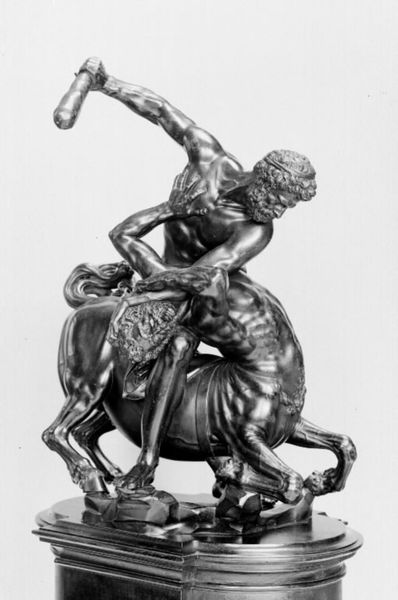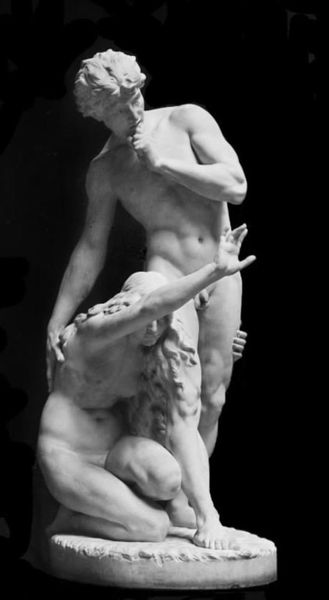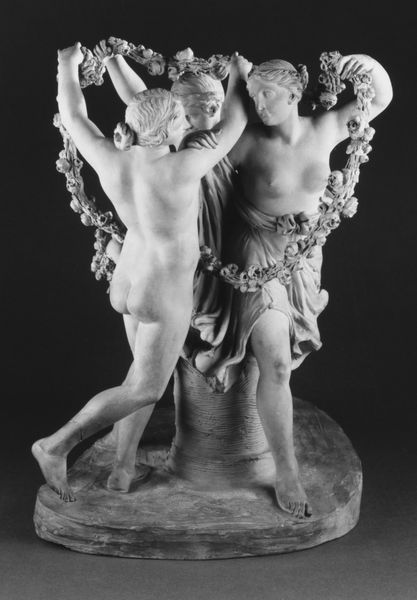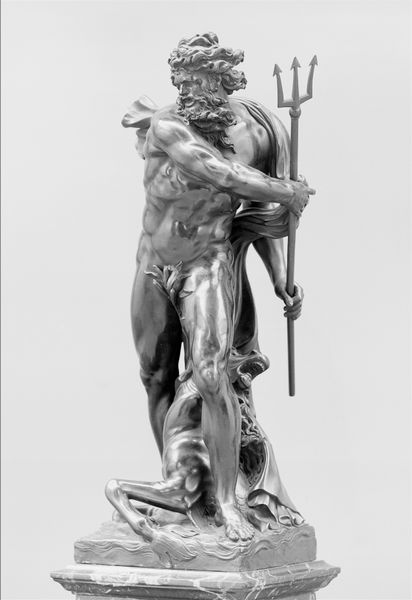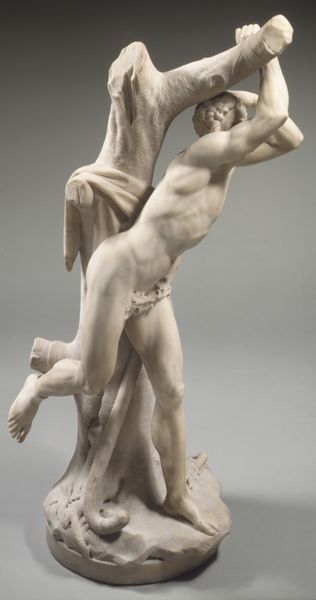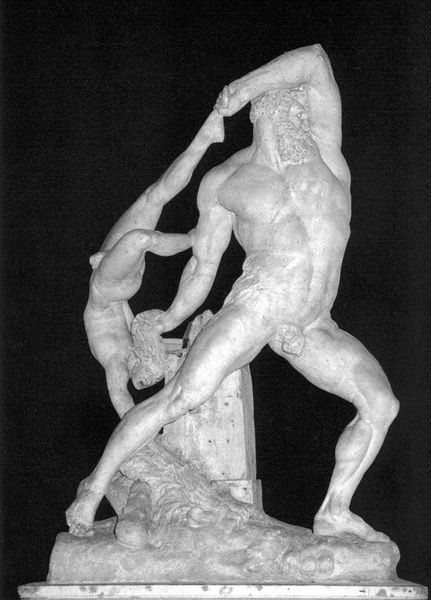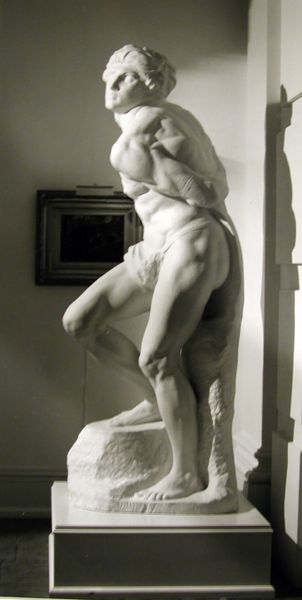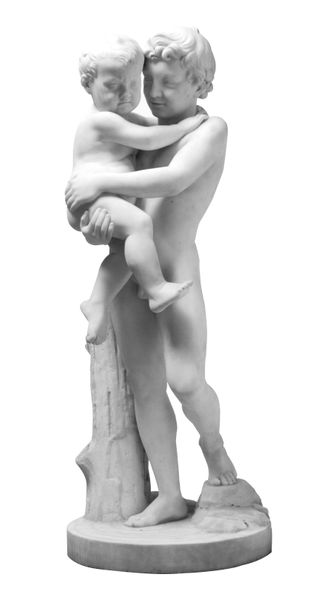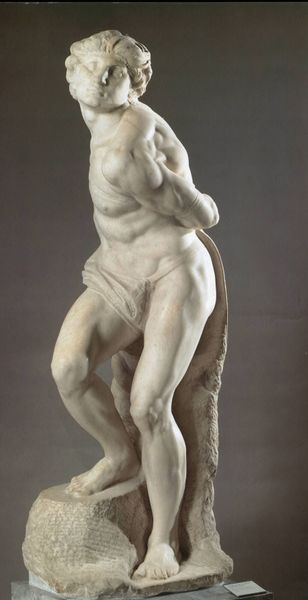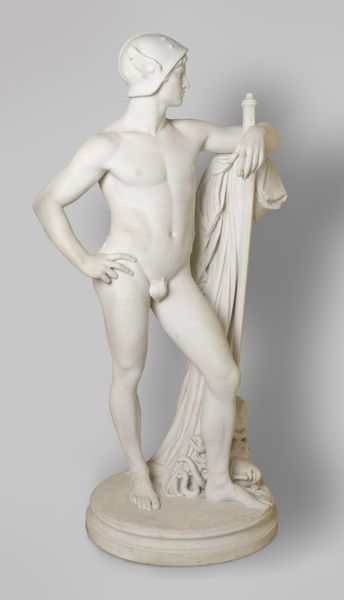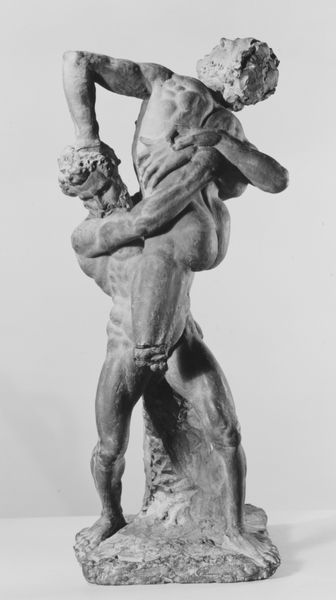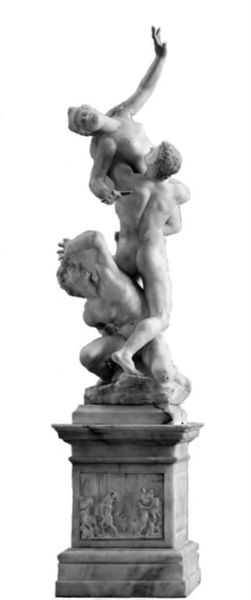
bronze, sculpture
#
portrait
#
sculpture
#
bronze
#
figuration
#
geometric
#
ancient-mediterranean
#
sculpture
#
history-painting
#
nude
#
realism
Dimensions: 209.5 cm (height) x 105 cm (width) x 65 cm (depth) (Netto)
Curator: Welcome. Before us stands "The Panther Hunter", a bronze sculpture created between 1845 and 1846 by J.A. Jerichau. It’s quite the dramatic scene, wouldn't you say? Editor: Yes, dramatic is the word. I am immediately drawn to the tension in the man's body. His muscles are so sharply defined, yet his face appears strangely placid in comparison to the fierce panther. The composition, too, is all diagonals and counter-thrusts – incredibly dynamic. Curator: Jerichau's sculpture operates on a potent blend of Neoclassical idealism and nascent Realism. Remember the rise of Natural History museums; the detailed depiction of the panther would have been prized for its perceived accuracy and contributes to its captivating appeal. The work portrays man’s dominance over nature, mirroring the political ambitions of a burgeoning colonial era. Editor: Interesting! Focusing on form, the contrast between smooth, idealized surfaces of the human figure and the textured, almost savage, quality of the panther's fur creates a stimulating tension. It’s like a study in contrasting materialities – a hallmark of academic sculpture but raised to new emotional heights. The light glints beautifully on the bronze, accentuating its undulating surfaces. Curator: Indeed, though the original plaster model, displayed in Copenhagen in 1846, may have heightened the emotional impact initially. Its later reproduction in bronze lent a sense of permanence and status, aligning it with classical precedents, as museums embraced sculpture as tools of national identity-building. The hero could have served as a role model of moral virtue and power. Editor: That touches on another critical element of the sculpture—its implicit classicism. Notice the nude male figure with the almost affectedly casual drapery, this is intended to evoke Greek sculpture and confer authority and value on the work through historical association. The panther motif is very intriguing in this setting too. Curator: It most certainly speaks to the complexities inherent to nation building in this period of intense societal change. Its meaning was less about accuracy, and more about embodying ideas that shaped society, making it a cultural artifact that mirrors and informs how power was perceived. Editor: It shows how technique can shape emotions, while revealing interesting period interpretations. "The Panther Hunter" is a truly outstanding synthesis.
Comments
statensmuseumforkunst almost 2 years ago
⋮
The hunter is raising his spear to administer the fatal blow. The struggle and violent discharge of energy is represented through a dynamic composition and a very naturalistic depiction of man and animal. Naturally, the dramatic moment is frozen in time, and spectators are called upon to complete the action themselves.Thorvaldsen's idealLike most Danish artists of the first half of the 19th century, J.A. Jerichau spent some time in Rome. Very symbolically, he arrived on the frigate sent to bring Thorvaldsen’s collections back to Denmark. Jerichau’s ambitions soon took him in directions other than the neoclassical restraint that was Bertel Thorvaldsen’s (1770-1844) ideal – and the ideal of the times.Depicting motion and specific momentsAs The Panther Hunter clearly demonstrates, classical calm and quiet did not interest Jerichau. He was more interested in depicting motion and specific moments in time with scenes packed with action and extrovert emotions.Jerichau's internatioal breakthroughThe Panther Hunter gave Jerichau his international breakthrough, bringing in several prestigious commissions from Denmark and abroad. In Denmark he was appointed professor at the Royal Danish Academy of Fine Arts and also served as its director for extended periods of time. Jerichau’s international outlook eventually set him on a collision course with the trend-setting Danish art circles who did not share his openness to international art trends.
Join the conversation
Join millions of artists and users on Artera today and experience the ultimate creative platform.
statensmuseumforkunst almost 2 years ago
⋮
Jerichau is equally interested in masculine ideas as evinced by THE PANTHER HUNTER and in cute animals and children at play. His treatment of figures and motifs has a distinctly sensuous quality; this in contrast to the cool, idealising sculptor Bertel Thorvaldsen. Jerichau’s romantic abundance of emotion was not universally appreciated on the Danish art scene, nor was his fervent interest in foreign movements, and he actively distanced himself from the wave of Danish patriotism that followed in the wake of the Schleswig wars in 1849-51 and 1864. Even though he and his wife, Elisabeth Jerichau Baumann, were branded as unpatriotic “Europeans”, he was nevertheless made professor at and director of the Royal Danish Academy of Fine Arts.
